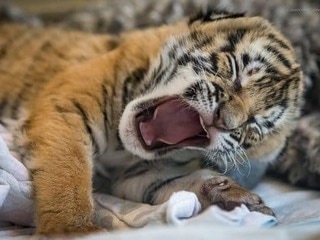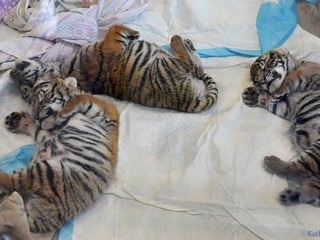I saw this incredible story and had to share it.
The Cincinnati Zoo & Botanical Garden's trio of two-week-old Malayan tiger cubs is doing well.
“They’re fed by nursery staff six times a day and have already graduated from two to three ounces per feeding,” Mike Dulaney, the zoo's curator of mammals and the vice coordinator of the Malayan Tiger Species Survival Plan (SSP), said in a news release. “Before they open their eyes, they usually just eat and sleep. Now that they can see where they’re going, they will start to become more active.”
But one of the cubs needed a little help from an unexpected source: A local chiropractor. Cub No. 1, as it has been deemed until its gender is known and a name has been given, was having trouble holding its head up.
“It was obvious to me that something wasn’t right," Dawn Strasser, a 35-year veteran in the zoo’s nursery, said in the release. “The cub’s neck appeared to be stuck at an odd angle. Massaging the neck muscles helped with the stiffness, but the cub was increasingly lethargic and not suckling well.”
Strasser brought in Dr. Mark Sperbeck, a chiropractor who works on both humans and animals. He determined that the cub’s top cervical bone (C1), through which 95 percent of the body's nerve impulses travel, was out of alignment.
After three adjustments, the cub's neck and spine are back in place. It's eating well and has actually gotten a little bigger than its littermates.
The Cincinnati Zoo & Botanical Garden's trio of two-week-old Malayan tiger cubs is doing well.
“They’re fed by nursery staff six times a day and have already graduated from two to three ounces per feeding,” Mike Dulaney, the zoo's curator of mammals and the vice coordinator of the Malayan Tiger Species Survival Plan (SSP), said in a news release. “Before they open their eyes, they usually just eat and sleep. Now that they can see where they’re going, they will start to become more active.”
But one of the cubs needed a little help from an unexpected source: A local chiropractor. Cub No. 1, as it has been deemed until its gender is known and a name has been given, was having trouble holding its head up.
“It was obvious to me that something wasn’t right," Dawn Strasser, a 35-year veteran in the zoo’s nursery, said in the release. “The cub’s neck appeared to be stuck at an odd angle. Massaging the neck muscles helped with the stiffness, but the cub was increasingly lethargic and not suckling well.”
Strasser brought in Dr. Mark Sperbeck, a chiropractor who works on both humans and animals. He determined that the cub’s top cervical bone (C1), through which 95 percent of the body's nerve impulses travel, was out of alignment.
After three adjustments, the cub's neck and spine are back in place. It's eating well and has actually gotten a little bigger than its littermates.


 RSS Feed
RSS Feed